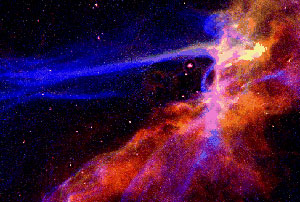 Most of us are killed after receiving
Most of us are killed after receiving
a large dose of gamma rays. For a select few,
the exposure can unleash our inner demons.
Image courtesy of
http://www.hulkmovie.com/navigation/multimedia.htm.
Continuing on the theme of Supernovae from my last posting, I’ll take this opportunity to address an earlier question that was asked by one of my loyal readers: “Perhaps your thoughts on the controversial topic of the effect of Gamma Rays on humans?”
Being a Berkeleyite and working at the home (www.lbl.gov) of the Gammasphere, I can’t help thinking of the Incredible Hulk when I read this question. In Marvel Comics, the Incredible Hulk was born when a brilliant but emotionally repressed Berkeley Physicist was exposed to an enormous dose of gamma radiation from his failed experiment. The genetic mutations from the exposure released his dark, hidden emotions in the persona of a savage dark green monster - a superhero with little wit or self-control.
Like visible light, gamma radiation is carried by photons. However, each photon in the gamma region of the electromagnetic spectrum has millions of times more energy than a red or blue photon that we see with our eyes. With so much energy, a gamma photon is capable of doing great damage by knocking the electrons around in living tissue like a pinball machine.
 The Veil supernova remnant.Credit: J. J. Hester (Arizona State University),
The Veil supernova remnant.Credit: J. J. Hester (Arizona State University),
WFPC, HST, NASA*
The largest source of gamma radiation is believed to be short, but intense gamma ray bursts. We are unsure of the exact nature of gamma ray bursts, but we suspect they may be the associated with supernovae. The intensity of a gamma ray burst implies that some energy from a supernova blast is focused like a laser beam. If this assumption is correct, then only a small fraction of supernova blasts will direct that beam of gamma rays at Earth.
